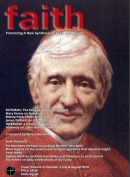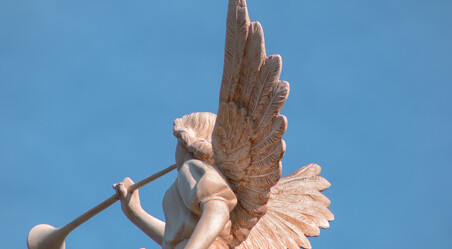Maximus on the Incarnation as Key to Hierarchy in Church and Creation
| John Gavin SJ FAITH Magazine November-December 2008 |
With help of the 6th century Saint Maximus the Confessor, Fr John Gavin S.J. draws out how, in the light of Christ’s incarnation and redemption, ecclesial hierarchy fulfils humanity. Fr Gavin, a Jesuit of the province of New Orleans, teaches Patristics at the Gregorian University in Rome.
The ecclesiastical hierarchy has become a much-maligned concept even within the Catholic Church herself. For many, the term smacks of an elitism that grates upon democratic sensibilities. The modern preference for fluidity and relativity finds it hard to accept an objective, never mind divinely established, order.
Two early Christian theologians – (pseudo-) Dionysius the Areopagite and St. Maximus the Confessor – offer us another perspective regarding this divinely established hierarchy. Their Neoplatonic cosmology, with its triads and ranks of celestial beings, may appear artificial to our contemporary mind; yet it is a vision deeply rooted in the scriptures and tradition. I would like briefly to consider the teachings of these two authors regarding the clerical orders and the significance of their teaching for today.
Dionysius and the Celebration of Rites
For centuries the Dionysian corpus – The Celestial Hierarchy, The Ecclesiastical Hierarchy, The Divine Names, The Mystical Theology, and a collection of letters – has been attributed to the renowned convert Dionysius the Areopagite, mentioned in Acts 17: 31. Contemporary scholars, however, have demonstrated that the works more likely belong to an unknown fifth century Christian. The technical terms and, in particular, the structure of The Divine Names IV, betray a clear dependence upon the thought of the Neoplatonist Proclus, while other references within the corpus indicate a fifth century dating.[1] Dionysius the Areopagite has become (pseudo-) Dionysius for future generations.
The questions regarding authorship, however, do not belie the significance of Dionysius’ Christocentric vision. The explanation of the orders of the clergy and the sacraments may reflect certain aspects of Dionysius’ contemporary situation – e.g., emphasis upon the sacramental triad of baptism, the Eucharist, and the consecration of the sacred oil – but the basic principles of these orders remain valid.
Dionysius defines a hierarchy as “a sacred order, a state of understanding and an activity approximating as closely as possible to the divine … It reaches out to grant every being, according to merit, a share of light and then through a divine sacrament, in harmony and in peace, it bestows on each of those being perfected its own form.”[2] Jesus is the head of this hierarchy, who purifies, illuminates, and divinises through the sacred orders: he desires to perfect all rational beings in “his own form”.[3] Thus, the purpose of the hierarchy is not to establish ranks of power, but it exists to unite all things with God and conform them to Christ. “The goal of a hierarchy, then, is to enable beings tobe as like as possible to God and to be at one with him.”[4]
The true actor in every hierarchy – celestial (the angels), ecclesiastical (the clergy), sacramental, and lay[5] – is Jesus Christ, who reveals his presence and bestows the overflowing gifts of his grace through the established ranks. For the ecclesiastical hierarchy of deacons, priests and bishops, this means that no member may claim to act on his own authority or power. He must humbly recognise that he acts in the name of Jesus and that his vocation as celebrant of the sacraments comes only from the One who has chosen to act in them. Jesus continues to strengthen and sanctify his Church through his servants, the ecclesiastical hierarchy, “effected so as to achieve a proportion appropriate to sacred objectives and so as to bring all theelements together in order into a cohesive and harmonious communion.”[6]
As a reflection of the celestial hierarchy (the angels), the ecclesiastical hierarchy consisting of the bishop, priest and deacon, follows two main principles. First, the bishop (or, in Dionysius’ term, the hierarch), who stands at the peak of the hierarchy, receives his authority and graces directly from Jesus. We can interpret this principle as being a refection of Jesus’ choice of the Apostles and the continuation of the Apostolic order in the Pope and the Bishops (Mt. 16:13-20). The lower orders in turn receive their consecration from Jesus, but always through the hierarch appointed by Christ. There is therefore never any question regarding the true actor and source of the spiritual gifts distributed through this triad of bishop, priest and deacon: one canalways climb the scale of orders to Jesus Christ himself.
Second, each level in the hierarchy both participates in the gifts of its superior and transmits its gifts to the inferior, always in proportion to the rank, i.e., the lower rank shares in the gifts of the superior, but not fully; the superior includes all of the gifts of the lower rank, in addition to other particular graces received from the rank above. Thus, the hierarch shares directly in the priesthood of Christ and therefore enjoys the fullness of the priesthood in the ecclesiastical hierarchy, but he is infinitely far from encompassing the totality of Christ in himself. He receives the mission to perfect the body of Christ that it may acquire the divine likeness, particularly through the celebration of the Eucharist:
And just as we observe that every hierarchy ends in Jesus, so each individual hierarchy reaches its term in its own inspired hierarch. The power of the order of hierarchs spreads throughout the entire company and works the special mysteries of its own hierarchy through all the sacred orders. But it is to this order especially, rather than to other orders, that divine law has bestowed the more divine workings of the sacred ministry. The rites are images of the power of the divinity, by which the hierarchs perfect the holiest of symbols and all the sacred ranks.[7]
This doctrine of Dionysius is reflected in the teachings of Lumen Gentium III:
The bishop, invested with the fullness of the sacrament of Orders, is “the steward of the grace of the supreme priesthood,” above all in the Eucharist, which he himself offers, or ensures that it is offered, from which the Church ever derives its life and on which it thrives […] For “the sharing in the body and blood of Christ has no other effect than to accomplish our transformation into that which we receive.” Moreover, every legitimate celebration of the Eucharist is regulated by the bishop, to whom is confided the duty of presenting to the divine majesty the cult of the Christian religion and of ordering it in accordance with the Lord’s injunctions and the Church’s regulations, as further defined for the diocese by his particular decision (48-49; 54-55).
The priest receives the mission of illuminating the Body of Christ. His celebration of the sacraments, instruction of the faithful, and personal example shine the divine light upon the faithful and draw them toward the Lord:
The light-bearing order of priests guides the initiates to the divine visions of the sacraments. It does so by the authority of the inspired hierarchs in fellowship with whom it exercises the functions of its own ministry. It makes known the works of God by way of the sacred symbols [the sacraments] and it prepares the postulants to contemplate and participate in the holy sacraments.[8]
Dionysius responds to those who observe that the priest in fact shares in the Bishop’s exclusive mission of perfecting through the celebration of the Mass: does the priest’s celebration of the Mass transgress the order of the ecclesiastical hierarchy?
Even if the priests can preside over some of the revered symbols [sacraments], a priest could not perform the sacred divine birth [baptism] without the divine ointment [the oils consecrated by the bishop], nor could he perform the mystery of Holy Communion without having first placed on the altar the symbols of that Communion. Furthermore, he would not even be a priest if the hierarch had not called him to this at his consecration.[9]
Once again we see Dionysius’ vision reflected in Lumen Gentium III:
Whilst not having the supreme degree of the pontifical office, and notwithstanding the fact that they depend on the bishops in the exercise of their own proper power, the priests are for all that associated with them by reason of their sacerdotal dignity; and in virtue of the sacrament of Orders, after the image of Christ, the supreme and eternal priest (Heb. 5:1-10; 7:24; 9:11-28), they are consecrated in order to preach the Gospel and shepherd the faithful as well as to celebrate divine worship as true priests of the New Testament. On the level of their own ministry sharing in the unique office of Christ, the mediator, (1 Tim. 2:5), they announce to all the word of God. However, it is in the Eucharistic cult or in the Eucharistic assembly of the faithful(synaxis) that they exercise in a supreme degree their sacred functions; there, acting in the person of Christ and proclaiming his mystery, they unite the votive offerings of the faithful to the sacrifice of Christ their head, and in the sacrifice of the Mass they make present again and apply, until the coming of the Lord (cf. 1 Cor. 11:26), the unique sacrifice of the New Testament, that namely of Christ offering himself once for all a spotless victim to the Father (cf. Heb. 9:11-28) (63-67).
Finally, the deacon has the responsibility of purifying the Body of Christ. This mission, for Dionysius, unfolds in the humble services that the deacon performed in the Church of the time, especially the preparation of the candidates before baptism. Some of these actions may appear surprising today:
The order of deacons purifies and discerns those who do not carry God’s likeness within themselves and it does so before they come to the sacred rites performed by the priests […] That is why during the rite of divine birth [baptism] it is the deacons who take away the postulant’s old clothes. It is they who untie [his sandals]. It is they who turn him west for the abjuration and then to the east, since theirs is the order and theirs the power of purification. It is they who call on him to cast aside the garments of his old life.[10]
We can, of course, also include the deacon’s celebration of the baptismal rite itself and his responsibility of preaching the Word that cleanses man’s heart and enkindles the living fame of the Gospel. In the words of Lumen Gentium III: “For, strengthened by sacramental grace they are dedicated to the People of God, in conjunction with the bishop and his body of priests, in the service of the liturgy, of the Gospel and of works of charity” (74).
We can now make a few observations regarding the hierarchical vision of Dionysius. First, as already noted, the purpose of the hierarchy of the clergy is not to dominate, but to divinise all the members of the body of Christ. It reflects the harmonious structure of God’s universe – celestial and material – while establishing an objective order of service and transmission of grace. The deification through the hierarchy “means for Denys [Dionysius] that the deified creature becomes so united to God that its activity is the divine activity flowing through it”.[11]
Second, the hierarchy humbles all of its members. Properly understood, every deacon, priest and bishop should see his place in the order as pure gift, a sharing in higher gifts in order that he might be at the service of others – clergy and lay. Furthermore, he acts in the name of Christ and through Christ’s grace, never through his own power. He must therefore comport himself as one who has received this great mission from the Lord, and empty himself on behalf of the Body of Christ.
Yet, despite the advantages of Dionysius’ vision, two problems stand out in particular. First, his conception of the hierarchical transmission of grace, while certainly true, can also obfuscate the importance of personal participation in the Body of Christ. At times Dionysius seems to imply that grace flows from Christ through the ranks like an electric current, raising up all members to the divine likeness, willing or not. Second, the rigidity of his hierarchy as an ontological plan for creation might sometimes lend itself to the idea that the Incarnation of the eternal Word was superfluous – all grace flows naturally through the ranks, from the divine Word at the peak on down to the faithful: the Incarnation of the Logos does act as a theophany – arevelation of God – but it seems hardly necessary for salvation. The Areopagite’s valuable contribution requires a corrective that recognises the value of the person and his relationship with Jesus. And we can find this in his great interpreter, Saint Maximus the Confessor.
St. Maximus and the Stages of the Spiritual Life
St. Maximus the Confessor (580-662) devoted his life to witness for the truth of the fullness of the incarnation of the Logos. The incarnation of the Logos, according to Maximus, is the very reason for creation from the beginning and the source of all deification or union with God: “All things were created through him, all things were created for him” (Col. 1:16). In fact, the Incarnation would have taken place even if there had not been a fall, since the Incarnation – the union of the logos of human nature with the divine Logos – was God’s intention from the beginning.[12] In the words of Maximus scholar Panayotis Christou: “Indeed, since man’s purpose was theosis, which he was not ableto achieve by his own means, the descent of God to man would be necessary under any circumstance, in order to facilitate man’s ascent. Man’s sin and fall were a fact which did not cause a new decision by God, but added a detail to the eternal design”.[13] Or better, in the words of Maximus himself: “This [the Incarnation] is the great and hidden mystery. This is the blessed end according to which all things are composed. This is the divine plan conceived before the beginning of all things … Looking toward this end, God brought the essences of all things into existence.”[14]
The concept of a divine “order” (taksis or thesis) in creation certainly plays a fundamental role within Maximus’ portrayal of the cosmic drama. God ordered the universe with the intention of becoming incarnate and making creatures one with himself. The structure of creation depends upon the eternal skopos, the divine plan for the Incarnation. Creation – even in its distinctions – therefore reflects an order directed toward an end in the Logos himself. As L. Thunberg notes: “As a whole the terms taksis or thesis thus confirm Maximus’ belief in creation as a result of a positive act of God, including as its purpose unity without violation [of the individual person]”.[15]
On the one hand, within this conception of an ordered universe, Maximus clearly accepts the general teachings of Dionysius regarding the hierarchical structure and the transmission of grace and illumination. He speaks of the celestial ranks of the angels in Dionysian terms and acknowledges the importance of the ecclesiastical hierarchy and the clerical missions. The hierarchical structure of the universe reveals and, in part, effects the unity with God through the transmission of grace and knowledge.
On the other hand, Maximus appears to find fault in the Areopagite’s strict representation of an order that tends to overrun the dignity of the person and the centrality of the Incarnation, rendering divinisation the inevitable outcome of a Neoplatonic “return to the source”, that is, to the Logos. J. M. Garrigues correctly notes that Maximus does assume Dionysius’ understanding of a cosmic order as a “vision of the communication of grace”, while at the same time avoiding the Areopagite’s “rigid, well-constructed hierarchy” as an ontological plan.[16] Thus, Maximus assumes the general Dionysian structure, but it does not have the same significance that one would find in most Neoplatonist works. He enriches the ontology andepistemology involved. The divine order exists, but the centrality of the incarnation of the Logos puts this hierarchy at the service of the person’s salvation and sanctification.
Regarding the ontological order of the cosmos, the order of providence takes precedence over the Dionysian hierarchy of being and illumination. Maximus’ emphasis upon the Incarnation highlights the order of the logoi – the divine willings or intentions for each created being united in the divine Logos – of providence, which directs creation toward its full expression as the likeness of God. The incarnate Word and the divine providence, which guides creation toward this telos, hold precedence in Maximus’ manner of speaking of divine immanence in creation.[17]
Returning to the theme of the Ecclesiastical hierarchy, one sees that Maximus acknowledges its importance, but he strives to bring out its significance for the personal growth in sanctity and communion with Christ. In his interpretation of the liturgy, the Mystagogia, Maximus has little to say about clerical orders, noting only that his master, Dionysius, had already treated this subject. Yet, he does offer a remarkable interpretation of the orders of deacon, priest and Bishop in his Chapters on Love:
The one anointing the mind for holy contests, and driving away from himself passionate thoughts, has the logos of deacon. The one enlightening [the mind] for knowledge of essences, and making falsifying knowledge disappear, has the logos of the priest. And the one fulfilling the mind by the myrrh of the knowledge of the worshipper and of the Holy Trinity, has the logos of the bishop.[18]
Maximus’ has given the Ecclesiastical hierarchy a new significance by fusing the Dionysian vision with the stages of the spiritual life described in the works of the fourth century monk, Evagrius Ponticus. Each clerical rank now represents not only a mission and a transmission of grace, but also a model for the person’s growth in the divine likeness.
The deacon, the purifier, represents the practical or ascetical stage. This involves the separation from the passions and growth in the virtues.[19] It requires a rational reorientation of the human person – in mind and body – toward the authentic logos of nature and the opening of the mind toward the action of God’s grace in love.[20] The individual Christian ideally should find in the humble service of the deacon – especially in his role in the celebration of the Mass – an example of self-abnegation and the virtue-filled life. Through the ascetic struggle of prayer, penance, fasting, and sacrifice, the person spiritually becomes the deacon.
The priest, the illuminator, represents the stage of natural contemplation, when man looks past the material world to see the true logoi of things.[21] “The mind arriving in the contemplation of visible things seeks either their natural reasons, or the things symbolised through them, or it seeks the cause itself of these things”. Through natural contemplation, man no longer falls into the deceptions of sensory experience, since he comes to the knowledge of the true unity of things in Christ.[22] The world becomes a theophany for him, a revelation of God and God’s providence. This takes place particularly through the celebration of the Eucharist, when thereal presence of Jesus under the species of bread and wine reveal and effect the union for which the universe longs. Through the grace of the sacraments and a spiritual vision, the person becomes the priest.
Finally, the bishop, the perfector, represents the stage of mystical theology, the abandonment of all material and intellectual constraints that come between the mind and the ineffable experience of the Trinity. This represents the actual stage of divinization, a form of knowledge “beyond knowledge”: “Theologia recalls the knowledge-process and its content; theosis [divinisation] stresses the formal effect of this knowledge-process: likeness with God, unity with God”.[23] Such a union cannot occur through human striving, since it is pure gift. Only the graces received in Baptism, Confession, and the Eucharist – graces flowing from Jesus’ abandonment of self to the Father on the Cross – transform andelevate the human person to the intimacy of divine unity. Through worthy participation in the sacraments the person spiritually becomes the Bishop.
St. Maximus and Suffering in Christ
It is now clear that, while accepting the divinely ordained hierarchy as an essential order of the transmission of Christ’s grace, Maximus also transforms this hierarchy into models of personal participation in the power of grace. Each person depends upon Jesus for his salvation and union with God (reflected in the objective order of the ecclesiastical hierarchy), but must also freely give himself over to the power of grace through growth in the spiritual life (the hierarchy of the stages of the spiritual life).[24]
For Maximus, the ecclesiastical hierarchy reflects and effects the goal of the Incarnation. On the one hand, the incarnate Word, Jesus, gave his life in obedience to the Father, saving man from sin and, through his resurrection and ascension, elevated man to the perfect union with the Father. “He is our repose as the one freeing the law from the contingent slavery in the flesh during the present life; our healing, as the one healing [us] of the affliction of death and destruction through his Resurrection; our grace, as the distributor of sonship in the Spirit by God the Father through faith, and of the grace of divinisation for each one according to worthiness.”[25]
The ecclesiastical hierarchy emerges from the divine communion as it is offered to man through the victorious Jesus, who now sits at the right hand of the Father, and renews itself and the Church through the celebration of the Eucharist. The bishop, priest, and deacon proclaim, reveal, and realise – through Christ – the hope of communion enabled and revealed by the Risen Lord.
On the other hand, the Incarnation restores man’s personal participation in this objective sanctifying order. Jesus, through his perfect obedience to the Father unto death, restores man’s capacity to suffer fruitfully or to concede freely to the action of grace – a capacity lost through the pride of Adam’s rejection of God’s will. Jesus restores, through his human will in union with the divine, the “willed concession”[26] or the “ecstatic power” of suffering[27] that allows the action of grace to elevate man “beyond nature” into the divine nature itself.
In and through Jesus, each individual believer strives to suffer or to concede to the transforming power of grace. He must struggle to liberate himself from sin through ascetical practice and acts of charity, suffering through his abandonment of the world; he must pass beyond the material illusions of this life to the spiritual realities through a loving participation in the sacraments; and, above all, he must welcome the gift of grace that transforms hearts of stone to hearts of flesh in the reception of the Eucharist, which is “the end of everything […] the sharing in the mystery. This transforms the people into itself […] through grace and participation – for the ones who have received it worthily.”[28] The ecclesiastical hierarchyreveals this transformative suffering in Christ to each and every believer, and makes this sanctification a work in progress.
The ecclesiastical hierarchy, therefore, is in no way a rigid order of suffocating power. On the contrary, it is an order of transformative suffering! Its ranks do not act in and of themselves, but serve as a theophany of the One who suffered for us and continues to act for us in the sacraments. And it calls each and every believer to abandon himself to Christ in love, to give himself daily over to the transforming power of grace. This truth is echoed in the words of Pope Benedict in his first homily:
If we let Christ enter fully into our lives, if we open ourselves totally to him, are we not afraid that He might take something away from us? Are we not perhaps afraid to give up something significant, something unique, something that makes life so beautiful? Do we not then risk ending up diminished and deprived of our freedom? And once again the Pope [John Paul II] said: No! If we let Christ into our lives, we lose nothing, nothing, absolutely nothing of what makes life free, beautiful and great. No! Only in this friendship are the doors of life opened wide.
The ecclesiastical hierarchy is truly a manifestation of the activity of Jesus, the One who suffered for us and raises creation to the eternal divine union.
[1] For a summary of the evidence cf. S. Lilla, Dionigi lAreopagita e il platonismo cristiano,Brescia 2005, pp. 159-162; C. Steel, Proculus et Denys: De l’existence du mal in Denys l’Aréopagite et sa postérité en Orient et en Occident, Paris 1997, pp. 89-116; H. D. Saffrey Un lien objectf entre le Pseudo-Denys et Proclus in Studia Patristica IX, ed. F. L. Cross, [TU 94], Berlin 1963, pp. 98-105. E. Corsini has some questions regarding certain points of the Koch-Stiglmayr hypothesis, and suggests that both Dionysius and Proclus could have been working with common sources, without any form of direct contact Cf. E. Corsini, Il Trattato “De divinis nominibus” dello Pseudo-Dionigi, Tornino 1962, pp. 12-35.
[2] Dionysius, Celestial Hierarchy (CH) III, 1, ed. G. Heil and A. M. Ritter, New York 1991 [PTS 36], p. 17. [English translation: Pseudo-Dionysius, The Complete Works,trans. C. Luibheid, New York 1987, pp. 153-154.] In subsequent notes I shall include the reference to the Greek critical edition and the translation by Luibheid.
[3] Dionysius, Ecclesiastical Hierarchy (EH) I, 1, ed. G Heil and A.M. Ritter, [PTS 36] pp. 63-64. [Lubheid, pp. 195-196]
[4] CHIII, 2, ed. Heil and Ritter, p. 17. [Lubheid, p. 154]
[5] For Dionysius, the triad of lay orders consists of monks, communicants and those being purified, i.e., the catechumens and the penitent
[6] EH V, 3, ed. Heil and Ritter, pp. 105-106. [Lubheid, p. 235)
[7] EH V, 5, ed. Heil and Ritter, p. 107. [Lubheid, p. 236-237]
[8] EH V, 6, ed. Heil and Ritter, p. 108. [Lubheid, p. 237]
[9] EH V, 5, ed. Heil and Ritter, p. 107. [Lubheid, p. 237]
[10] EH V, 6, ed. Heil and Ritter, p. 109. [Lubheid, p. 239]
[11] A. Louth, Denys the Areopagite, Wilton, Ct., 1989.
[12] Maximus the Confessor, Questiones ad Thalassium, 60, CCSG 22, p. 75, 33-38. One also finds this assertion in other Fathers of the Church, in particular, St Irenaeus. Cf. Irenaeus of Lyons, On the Apostolic Preaching, 12, trans. J. Behr, New York 1997, p. 47.
[13] P Christou, Maximus Confessor on the Infnity of Man, in Maximus Confessor. Actes du Symposium sur Maxime le Confesseur, ed. F Heinzer and C. Schhönborn, Fribourg 1982, p. 268.
[14] Maximus the Confessor, Questiones ad Thalassium, 60, CCSG 22, p. 75, 33-38.
[15] L. Thunberg, Microcosm and Mediator, p. 63. Also cf. H. von Balthasar, Kosmische Liturgie, pp. 116-117.
[16] J. M. Garrigues, Maxime le Confesseur: La charité, avenir divin de l’homme, Paris 1976, p. 86. Also cf. W. Völker, Der Einfuß des Pseudo-Dionysius Areopagita auf Maximus
Confessor, in Studien zum Neuen Testamente und zur Patristik: Festschrift Erich Klostermann, [TU 77], Berlin 1961, pp. 339-342.
[17] Cf Ambigua ad Ioannem (Amb. Io.)10, PG 91, 1188 D-1189 A.
[18] Capita de caritate (Car.) II, 21, A. Ceresa-Gestaldo, Roma 1963, p. 100.
[19] Man does not “create” the virtues, but manifests the divine qualities that are innate to his being. Christ himself is the sum of all virtues and the “exegete” of all virtues, which means that growth in virtue is to grow in Jesus’ likeness. Cf. Amb Io. 10, PG 91, 1109 A.; Amb Io. 7, PG 91,1081 D; Amb Io. 10, PG 91, 1133 D
[20] Reason (logos) serves as man’s chief faculty in the practical life, being the “exegete” of the virtues and the guide toward the Good. Amb Io. 10, PG 91, 1109 B.
[21] Car. I, 98, A. Ceresa-Gastaldo, p. 88.
[22] In natural contemplation man possesses “the generative Logos of everything, revealed in faith through the order of visible things.” Ad Thalassium (Thal.) 25, C. Laga and C. Steel, CCSG 7, p. 161, 35-37.
[23] J. Loosen, Logos und Pneuma in begnadeten Menschen bei Maximus Confessor, Munster 1941, p. 81.
[24] It should be noted that climbing the spiritual hierarchy is rarely a consistent process. Rather, in our daily struggle, we fnd ourselves stumbling and rising during our pilgrimage of hope toward the perfect union with God, which will only occur in the general resurrection.
[25] Thal. 64, CCSG 22, pp. 195-197, 152-158.
[26] Cf. Amb. Io., 7, PG 91, 1076 C.
[27] “Suffering is the ecstatic power that leads that which suffers toward that which acts” Amb. Io., 7, PG 91, 1088 D
[28]Mystagogia (Myst), XXI, PG 91, 697 A.





